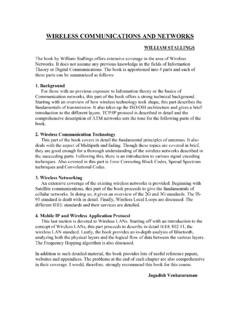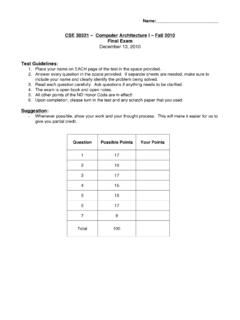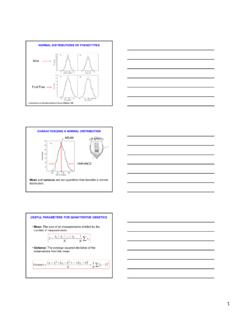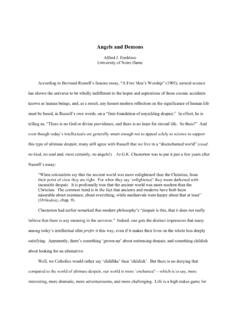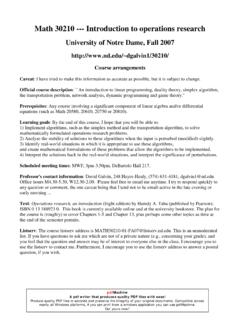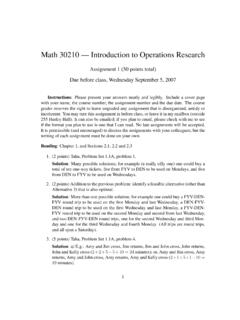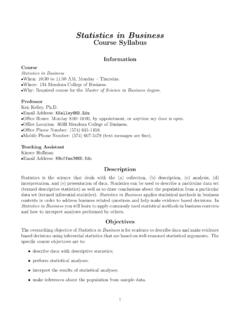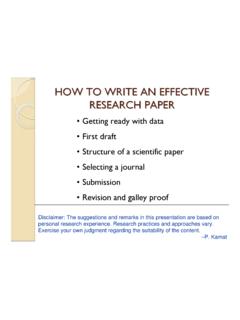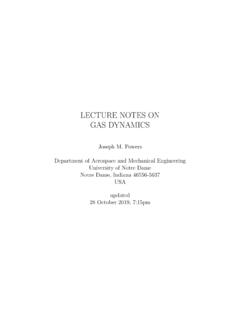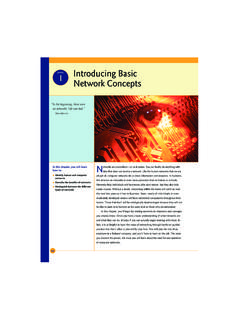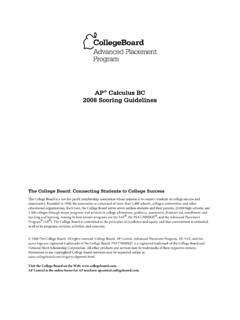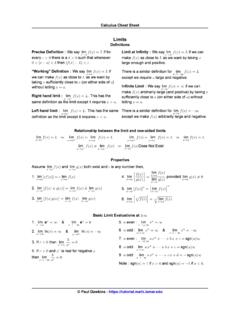Transcription of Intermediate Macroeconomics - University of Notre Dame
1 Intermediate Macroeconomics Julio Gar n Robert Lester Claremont McKenna College Colby College Eric Sims University of Notre Dame August 2, 2018. This Version: This is a book designed for use in an Intermediate Macroeconomics course or a masters level course in Macroeconomics . It could also be used by graduate students seeking a refresher in advanced undergraduate Macroeconomics . This book represents a substantial makeover and extension of the course notes for Intermediate Macroeconomics which have been provided publicly on Eric Sims's personal website for several years. There are many fine textbooks for Macroeconomics at the Intermediate level currently available. These texts include, but are certainly not limited to, Mankiw (2016), Williamson (2014), Jones (2013), Barro (1997), Abel, Bernanke, and Croushore (2017), Gordon (2012), Hall and Pappell (2005), Blanchard (2017), Dornbusch, Fischer, and Startz (2013), Froyen (2013), and Chugh (2015).
2 Given the large number of high quality texts already on the market, why the need for a new one? We view our book as fulfilling a couple of important and largely unmet needs in the existing market. First, our text makes much more use of mathematics than most Intermediate books. Second, whereas most textbooks divide the study of the macroeconomy into two runs (the long run and the short run), we focus on three runs the long run, the medium run, and the short run. Third, we have attempted to emphasize the microeconomic underpinnings of modern Macroeconomics , all the while maintaining tractability and a focus on policy. Fourth, we include a section on banking, bank runs, bond pricing, and the stock market. While this material is generally left to money, credit, and banking texts, the recent Great Recession has taught us the importance of thinking seriously about the implications of the financial system for the macroeconomy.
3 Finally, we feel that a defining feature of this text is that it is, if nothing else, thorough we have tried hard to be very clear about mathematical derivations and to not skip steps when doing them. Modern economics is increasingly quantitative and makes use of math. While it is important to emphasize that math is only a tool deployed to understand real-world phenomena, it is a highly useful tool. Math clearly communicates ideas which are often obfuscated when only words are used. Math also lends itself nicely to quantitative comparisons of models with real-world data. Our textbook freely makes use of mathematics, more so than most of the texts we cited above. An exception is Chugh (2015), who uses more math than we do. To successfully navigate this book, a student needs to be proficient at high school level algebra and be comfortable with a couple of basic rules of calculus and statistics. We have included Appendices A and B to help students navigate the mathematical concepts which are used throughout the book.
4 While we find the approach of freely integrating mathematics into the analysis attractive, we recognize that it may not be well-suited for all students and all instructors. We have therefore written the book where the more involved mathematical analysis is contained in Part III. This material can be skipped at the instructor's discretion, 1. which allows an instructor to spend more time on the more graphical analysis used in Parts IV and V. Traditionally, macroeconomic analysis is divided into the long run (growth) and the short run (business cycles). We have added a third run to the mix, which we call the medium run. This is similar to the approach in Blanchard (2017), although we reverse ordering relative to Blanchard, studying the long run first, then the medium run, then the short run. Our principal framework for studying the long run in Part II is the canonical Solow model. We are attracted to this framework because it clearly elucidates the important role of productivity in accounting for both long run growth and cross-country income differences.
5 A. drawback is that the Solow model does not formally model microeconomic decision-making, as we do throughout the rest of the book. To that end, we have also included Chapter 8. using an overlapping generations framework with optimizing agents. This framework touches on many of the same issues as the Solow model, but allows us to address a number of other issues related to efficiency and the role of a government. Whereas growth theory studies the role of capital accumulation and productivity growth over the span of decades, we think of the medium run as focusing on frequencies of time measured in periods of several years. Over this time horizon, investment is an important component of fluctuations in output, but it is appropriate to treat the stock of physical capital as approximately fixed. Further, nominal frictions which might distort the short run equilibrium relative to an efficient outcome are likely not relevant over this time horizon.
6 Our framework for studying the medium run is what we call the neoclassical model (or real business cycle model). In this framework, output is supply determined and the equilibrium is efficient. The microeconomic underpinnings of the neoclassical model are laid out in Part III. and a full graphical treatment is given in Part IV. We think of the short run as focusing on periods of time spanning months to several years. Our framework for studying the short run is a New Keynesian model with sticky prices. This analysis is carried out in Part V. The only difference between our medium and short run models is the assumption of price rigidity, which makes the AS curve non-vertical otherwise the models are the same. We consider two different versions of the sticky price model one in which the price level is completely predetermined within period (the simple sticky price model) and another in which the price level is sensitive to the output gap (the partial sticky price model).
7 With either form of price stickiness, demand shocks matter, and the scope for beneficial short run monetary and/or fiscal policies becomes apparent. Optimal monetary policy and complications raised by the zero lower bound (ZLB) are addressed. Appendix D. develops a sticky wage model which has similar implications to the sticky price model. Modern Macroeconomics is simply microeconomics applied at a high level of aggregation. 2. To that end, we have devoted an entire part of the book, Part III, to the Microeconomics of Macroeconomics . There we study an optimal consumption-saving problem, a firm profit maximization problem in a dynamic setting, equilibrium in an endowment economy, and discuss fiscal policy, money, and the First Welfare theorem . Whereas for the most part we ignore unemployment throughout the book and instead simply focus on total labor input, we also include a chapter on search, matching, and unemployment.
8 The analysis carried out in Part III serves as the underpinning for the remainder of the medium and short run analysis in the book, but we have tried to write the book where an instructor can omit Part III should he or she choose to do so. Relatedly, modern Macroeconomics takes dynamics seriously. We were initially attracted to the two period macroeconomic framework used in Williamson (2014), for which Barro (1997) served as a precursor. We have adopted this two period framework for Parts III through V. That said, our experience suggested that the intertemporal supply relationship (due to an effect of the real interest rate on labor supply) that is the hallmark of the Williamson (2014) approach was ultimately confusing to students. It required spending too much time on a baseline market-clearing model of the business cycle and prevented moving more quickly to a framework where important policy implications could be addressed.
9 We have simplified this by assuming that labor supply does not depend on the real interest rate. This can be motivated formally via use of preferences proposed in Greenwood, Hercowitz, and Huffman (1988), which feature no wealth effect on labor supply. We were also attracted to the timeless IS-LM approach as laid out, for example, so eloquently by Mankiw (2016), Abel, Bernanke, and Croushore (2017), and others. Part V. studies a short run New Keynesian model, freely making use of the commonly deployed IS-LM-AD-AS analysis. The medium run model we develop graphically in part IV can be cast in this framework with a vertical AS curve, which is often called the long run supply curve (or LRAS) in some texts. Because of our simplification concerning the dynamic nature of labor supply in Part IV, we can move to the short run analysis in Part V quicker. Also, because the medium run equilibrium is efficient and the medium run can be understood as a special case of the short run, the policy implications in the short run become immediately clear.
10 In particular, policy should be deployed in such a way that the short run equilibrium (where prices are sticky) coincides with the medium run equilibrium. Price stability is often a good normative goal, and monetary policy ought to target the natural or neutral rate of interest, which is the interest rate which would obtain in the absence of price or wage rigidities. This Wicksellian framework for thinking about policy is now the dominant paradigm for thinking about short run fluctuations in central banks. Within the context of the IS-LM-AD-AS model, we study the zero lower bound and an open economy version of 3. the model. Jones (2013) proposes replacing the LM curve with the monetary policy (MP). curve, which is based on a Taylor rule type framework for setting interest rates. We include an appendix, Appendix E, where the MP curve replaces the LM curve. Finally, the recent Great Recession has highlighted the importance of thinking about connections between the financial system and the macroeconomy.
